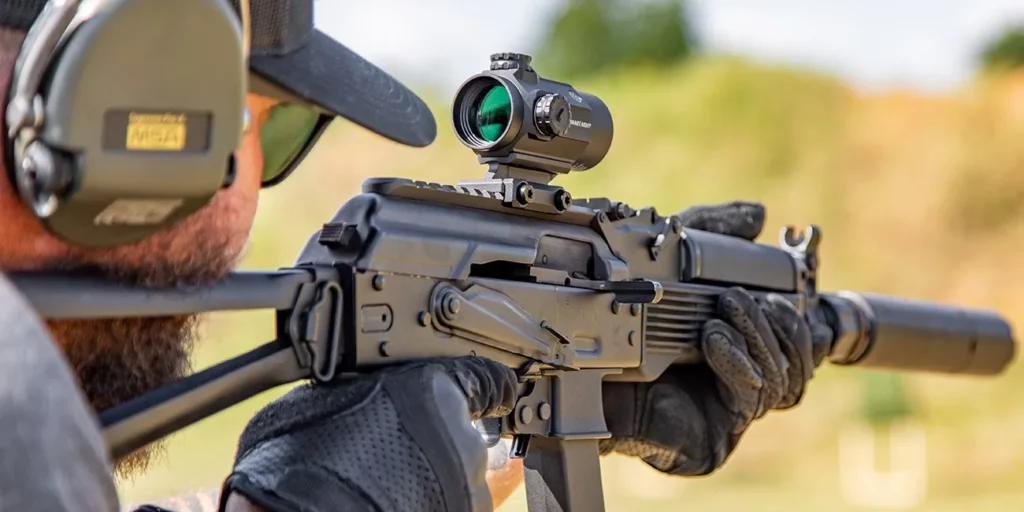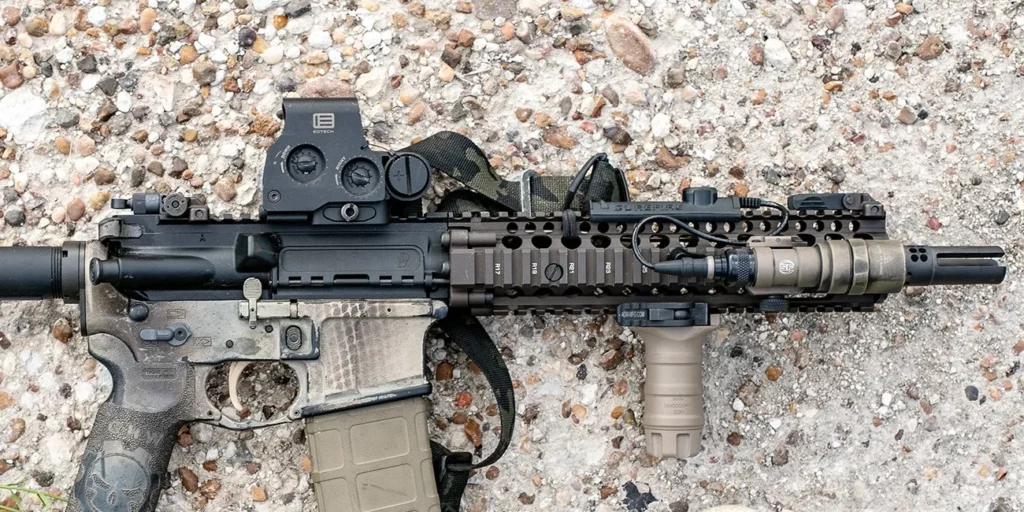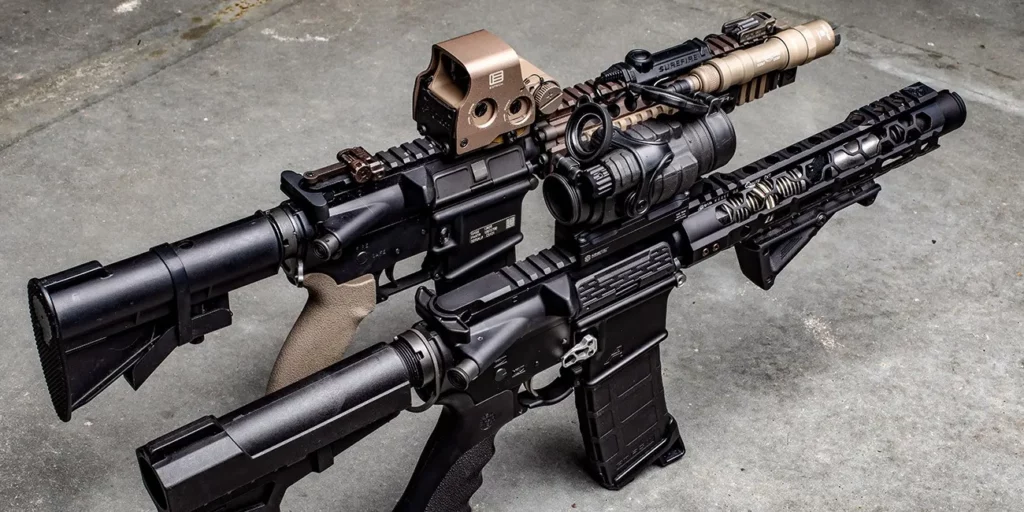Holographic vs Red Dot
For decades, firearms enthusiasts have debated over the best close-quarters optic: holographic vs red dot sights. From a performance perspective, these two optic designs have many similar features and benefits. Both holographic sights and red dot sights provide a bold, illuminated reticle with unlimited eye relief and zero magnification. Both sights are designed around quick target acquisition. Both sights run on battery and operate in conjunction with a rear magnifier.
However, once you start looking at internal mechanics, you’ll find that holographic sights and red dot sights are very different technologies. In this blog, we’ll explain the technology behind holographic vs red dot sights. We’ll also highlight each design’s major benefits, helping you make the right decision when outfitting your carbine.

Holographic vs Red Dot: How Red Dot Sights Work
The exact definition of a ‘red dot sight’ can be somewhat tricky since many overlapping and parallel optic designs blur the lines between a ‘red dot’ and the much broader category of ‘reflex sights’.
Reflex sights include all optics that use reflective glass to superimpose an aiming point over the user’s field of view. Red dot sights are a subsection of reflex optics, and while there’s no perfect definition of a red dot sight, we have an internal definition that we use when building our optics.
Red dot sights utilize a bright LED emitter, which is reflected against a forward spheric or aspheric lens. In a red dot sight, the emitter and lens adjust as a single combined assembly. This is in contrast to other reflex sights, where the forward lens is fixed, and adjustments only move the emitter.
A red dot’s objective lens receives special coatings that only reflect the LED’s wavelength of light. Depending on which coatings are used, the lens might appear slightly blue when looking through the sight. Overall, the traditional red dot design is simple, efficient, and easily scaled to fit a wide variety of roles.
Holographic vs Red Dot: How Holographic Sights Work
Now that you understand the basics of red dot sights, how do holographic sights differ?
Mechanically, holographic sights are almost nothing like red dot sights, though they might still be considered ‘reflex sights’ in that they use reflective lenses. Holographic sights do not use an LED emitter—nor do they reflect off the front lens. In fact, the technology inside a holographic sight is far more complex, which is why holographic optics tend to cost more than red dots.
Instead of an LED, Holographic sights employ an actual laser, which bounces off a collimating reflector and holographic grating before finally passing through the rear lens. The result is a fine reticle image that appears to float out at a distance over your target. The technology is incredible, and so too is the company that founded it.
Shop All In Stock EOTechBuy Now
EOTech made their first holographic weapon sights in the late 90s, and they’ve protected their technology with countless patents. In today’s market, the only real competitor to EOTech is Vortex with their Razor AMG UH-1 holographic sight, though EOTech’s decades of prominence and trust keep it firmly in the spotlight.

Holographic vs Red Dot: Performance
If you look at their prime benefits, both red dot sights and holographic sights deliver a similar advantage.
Both optics enhance close-quarters agility, optimal for use in close-quarters carbines and personal defense weapons. Both optics have seen use with the US Military and American police for near-identical roles. Both optics draw from the same fundamental marksmanship skills, which can be used interchangeably between either system.
There are some important distinctions in performance, though, so when you’re shopping for a new optic, you should pay attention to some of the following areas:
Battery Life
When you compare holographic vs red dot sights on battery life, there’s really no contest.
Red dots use a highly efficient LED emitter that can run for tens of thousands of hours on a single battery. The probability of having a battery run dry in the middle of use is very unlikely, especially if your red dot has a built-in sleep mode or solar panel. The actual runtime will vary depending on your environment, as we discussed in our interview with a SOCOM operator, but in general, red dots have very long battery life. Even budget-friendly sights like our SLx Advanced Rotary Knob Microdot achieve up to 50,000-hours of runtime.
Primary Arms SLx Advanced Rotary Knob Microdot Red Dot SightBuy Now
Holographic sights have a good runtime, but it’s nowhere near as long as a red dot sight. On nominal settings, the EOTech EXPS 3.0 offers between 600-1000 hours of runtime on a single battery. This runtime is alright, but when you consider that it’s about 2% of a red dot’s battery life, the problem seems more apparent. Holographic sights are slowly getting more efficient, but a laser will probably never have the same runtime as an LED emitter.
Weight
Due to their simplicity, red dots are a lot more flexible when it comes to size and weight. The smallest red dot sights fit on a fingertip and weigh only a couple ounces. Even an average micro red dot sight weighs between 4 and 6 ounces, so you’re getting a lot of functionality and durability without compromising on agility.
Holographic sights are considerably heavier, but don’t let that scare you. The EOTech EXPS3 weighs just over 11oz, which is still plenty nimble—especially when compared to many magnified optics.
EOTech XPS3-2 Holographic Weapon SightBuy Now
Durability
This subject gets a lot more play than is deserved, but we’d like to set the record straight.
Quality red dot sights are durable. Quality holographic sights are durable. There is no definitive evidence that one design is universally stronger than the other.
We’ve all read plenty of stories and fiery opinions about how the ‘X brand’ always broke while the ‘Y brand’ always survived. There is something to be said for personal experience, but always take stories with a grain of salt.
In reality, there are differences in the designs that give them both some durability advantages. Sure, red dot sights are simpler, but holographic sights have advantages too. For example, holographic sights don’t rely on their front lens to reflect the reticle, so even if the front lens takes a hit, you should still see your reticle clearly.
Both red dot sights and holographic sights have seen warfare in every environment on this planet. Most quality optics can take a lot of abuse before something fails, and when failures happen, they should be viewed on a case-by-case basis.

Parallax
If you’re shooting from an alternate position, such as under a vehicle, you might have a hard time lining up behind your optic. One of the biggest benefits of red dot sights and holographic sights is that they’re usable in these awkward positions, so long as the reticle is visible through the window of the optic. Unlike magnified optics, red dot and holographic sights don’t have an eye box or eye relief to overcome—but that doesn’t mean you can ignore parallax.
By textbook definition, parallax is, “a displacement or difference in the apparent position of an object viewed along two different lines of sight and is measured by the angle or semi-angle of inclination between those two lines.”
For red dots and holographic sights, parallax is observed when the marksman moves their eye behind the optic. With any movement, the reticle and image both seem to move, but they might move at slightly different rates. If an optic has a lot of parallax error, then the reticle will appear to move faster than the target, effectively placing the reticle off its point of impact. This phenomenon is observable on both red dot sights and holographic sights, but the extent of it will vary from optic to optic.

Most red dot and holographic sights are set to be ‘parallax-free’ at a specific distance, but outside that distance, there will be some amount of error. At close range, you might not notice it, but if you’re doing high movement drills with targets at ranges beyond 200 yards, parallax error can inhibit your accuracy.
In comparative testing, EOTech’s EXPS and XPS holographic sights have the least parallax error on the market, though the latest red dots are close competitors.
Reticles
In the past, holographic sights dominated when it came to reticle selection, but that is no longer the case.
Nowadays, many optics manufacturers offer versions of their red dot sights with similar circle-dot reticles. These reticles have only recently become possible with the progression of emitter technology, but their mechanics are almost identical to a standard red dot sight. This is best exemplified on sights such as the co-branded Holosun HS503G, which features one of our patented ACSS® reticle designs.
Holosun Paralow HS503G Red Dot Sight – ACSS CQB ReticleBuy Now
Why Choose a Holographic Sight
There are a few scenarios where holographic sights have a slight advantage over red dot sights.
If you intend to run a magnifier, holographic sights have an advantage due to the sizing of the reticle’s center dot. EOTech advertises their center dot as 1MOA, but this is not technically correct. In reality, that center aiming point is much, much smaller than 1MOA, but your eyes are resolving it to that 1MOA size. This distinction gives EOTech sights an added benefit when used with a magnifier, as the magnifier will not visibly increase the size of your center dot. In fact, under a magnifier, the EOTech reticle may even appear sharper and more defined—which can be very beneficial when taking shots at further distances.
Shop All In Stock Red Dot MagnifiersBuy Now
Holographic sights are also great for low-light and nighttime shooting since the lens is nonreflective and draws in ample light. Under night vision, holographic sights are very easy to use in passive aiming, and the window size means that you’re not being obstructed by the blur of the housing.

Why Choose a Red Dot Sight
Since we’ve highlighted reasons to use holographic sights, here are a few reasons to consider a red dot sight.
First, red dot sights can be a lot lighter and smaller than holographic sights. If you’re trying to minimize your carbine’s weight, a micro red dot sight can shave some ounces off the top without compromising on durability or function. This can be especially beneficial for small PDW-type firearms, which are meant to be concealed in bags or under clothing.
Shop In Stock AR-15 PistolsBuy Now
Second, red dot sights have a long battery life, so if you’re setting a carbine aside for emergency use, you can leave the red dot sight on without worrying about the battery. For home defense rifles, runtime means peace of mind, as you know that your rifle is ready to go at all times.
Finally, if you’re building on a tight budget, red dot sights tend to be much more affordable. While it’s true that the latest Aimpoint will cost just as much (if not more) than an EOTech, there are plenty of high-quality value red dots on the market. With confidence, we can say that since we founded our company on making better budget-friendly red dot sights.

Holographic vs Red Dot: The Take-Away
If there’s one thing to take away from the comparison, let it be this:
Both holographic and red dot sights bring a lot of great features to the table, and though they’re different in manufacturing, either optic will give you a tremendous advantage over iron sights. While enthusiasts will continue to debate this subject to eternity, we’re confident that most customers would be very satisfied with both holographic and red dot sights, especially for use in high-movement, close-quarters environments.
But if you have more to say on the matter, let us know!
You can always reach us on social media by visiting our Facebook, Instagram, and Twitter pages. We’re always happy to discuss blog subjects with our readers, so if you’ve got something you’d like to say, please feel free to reach out!



